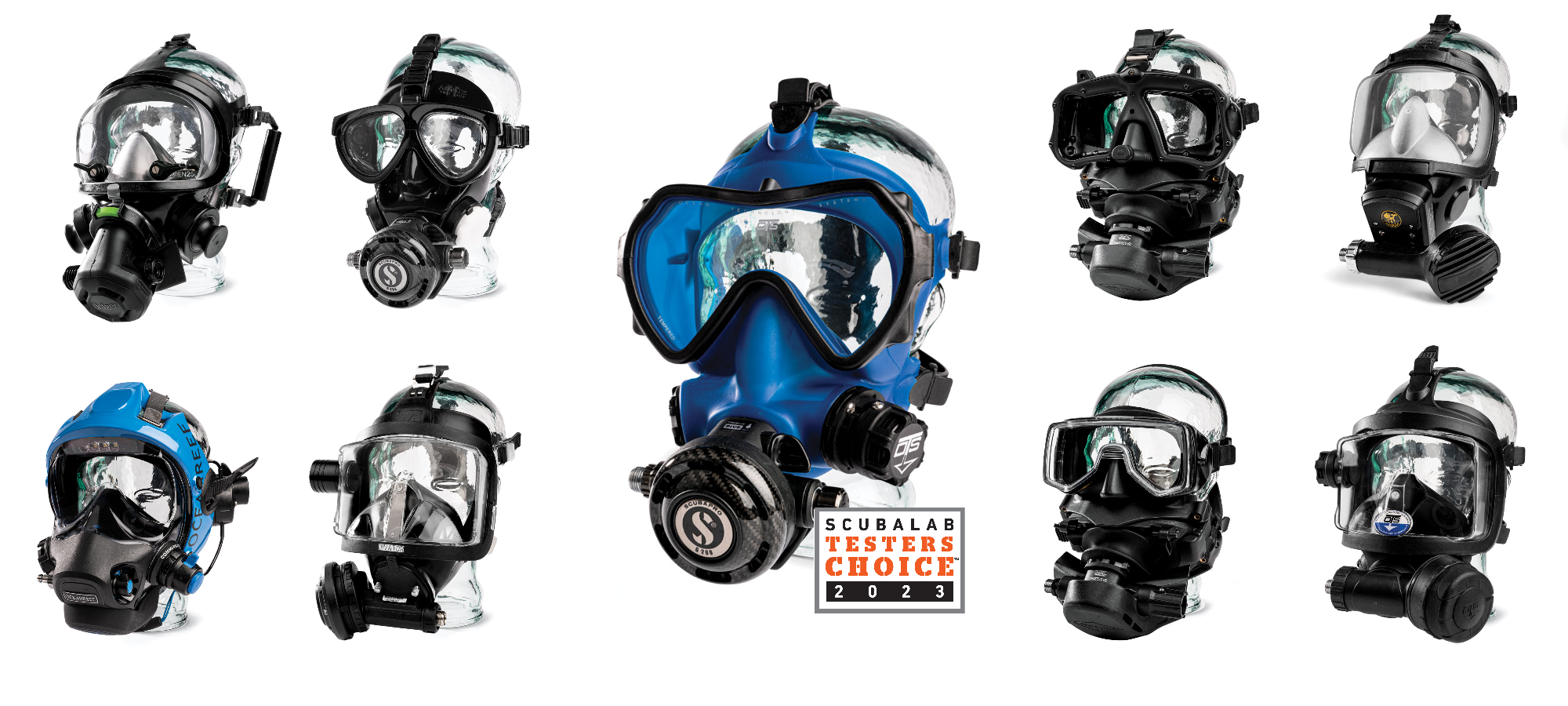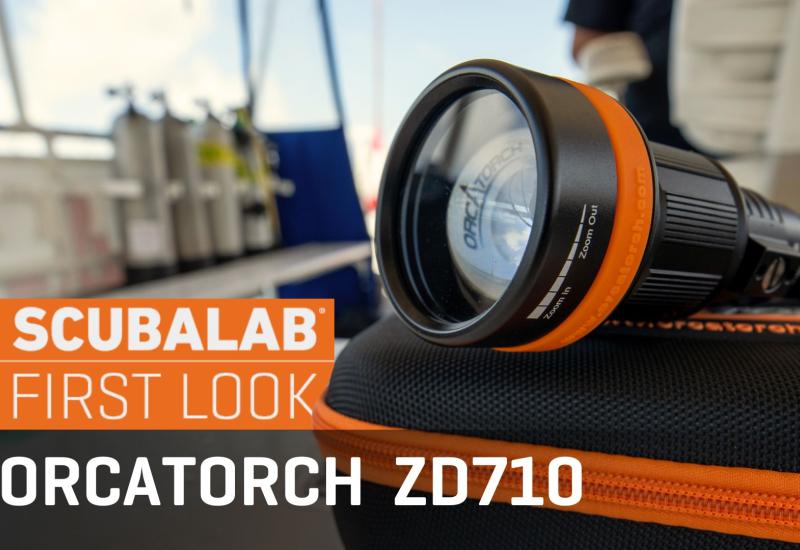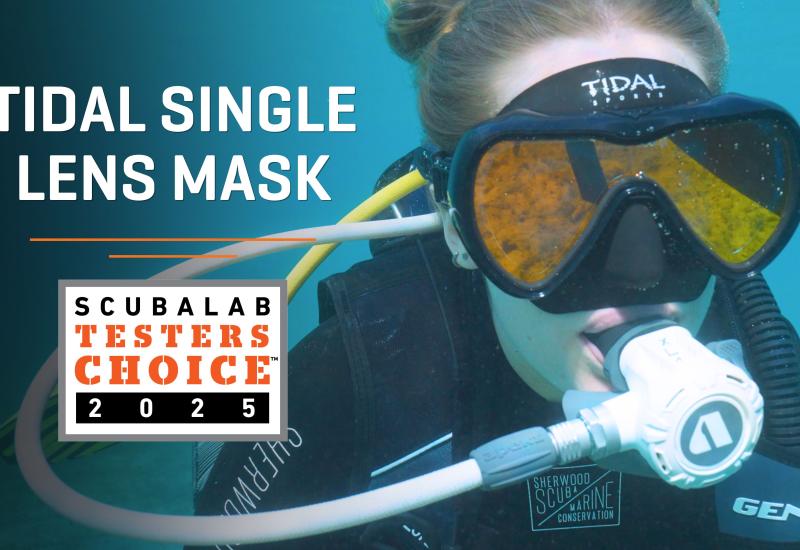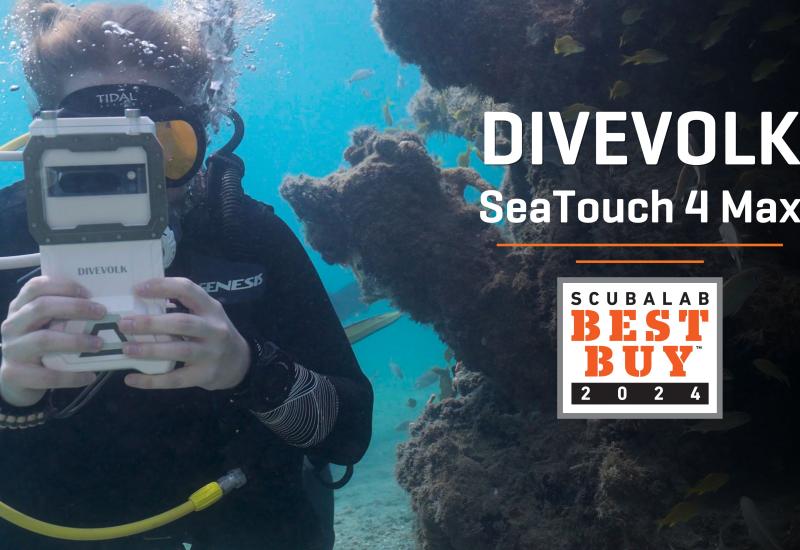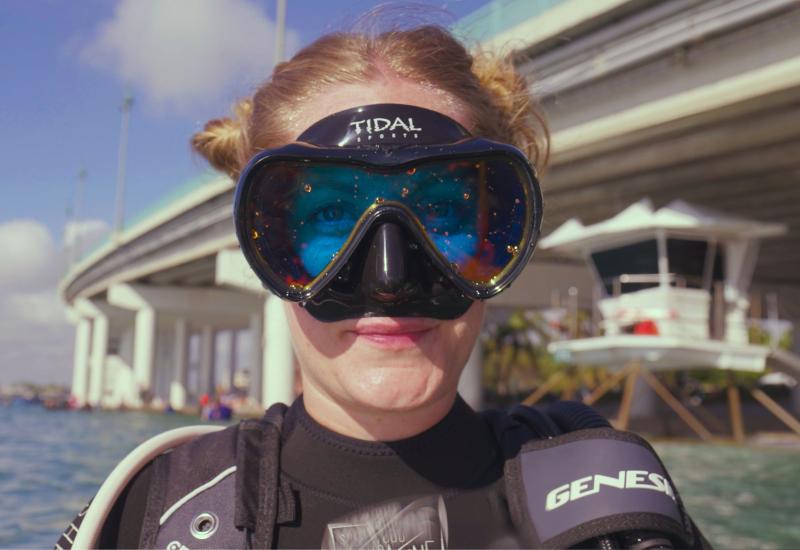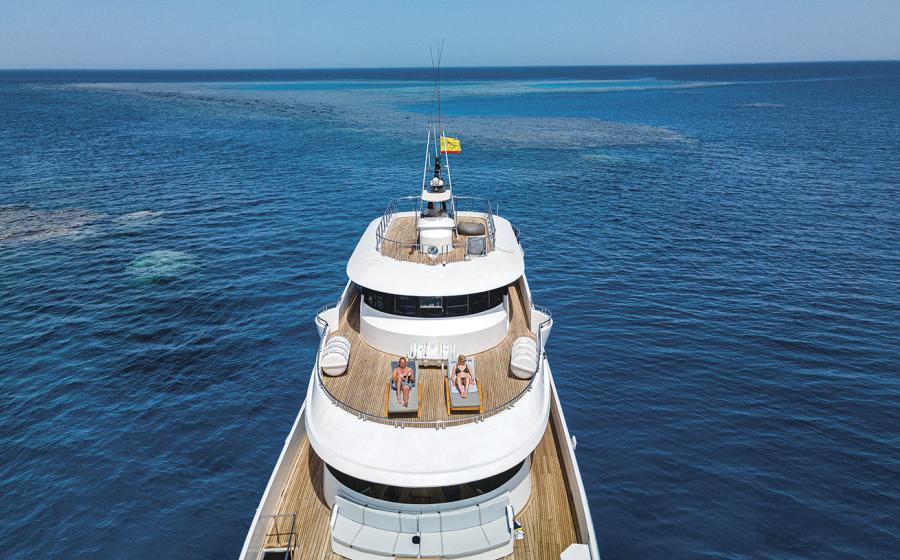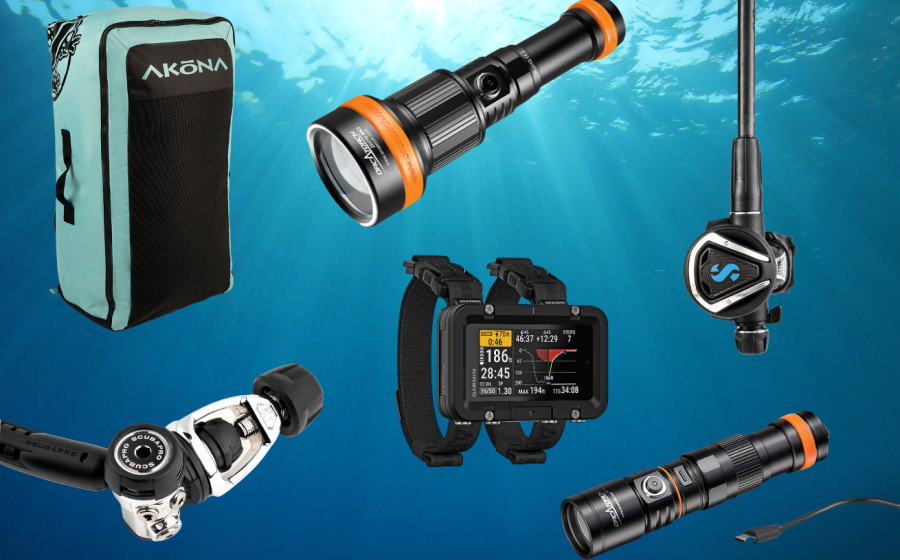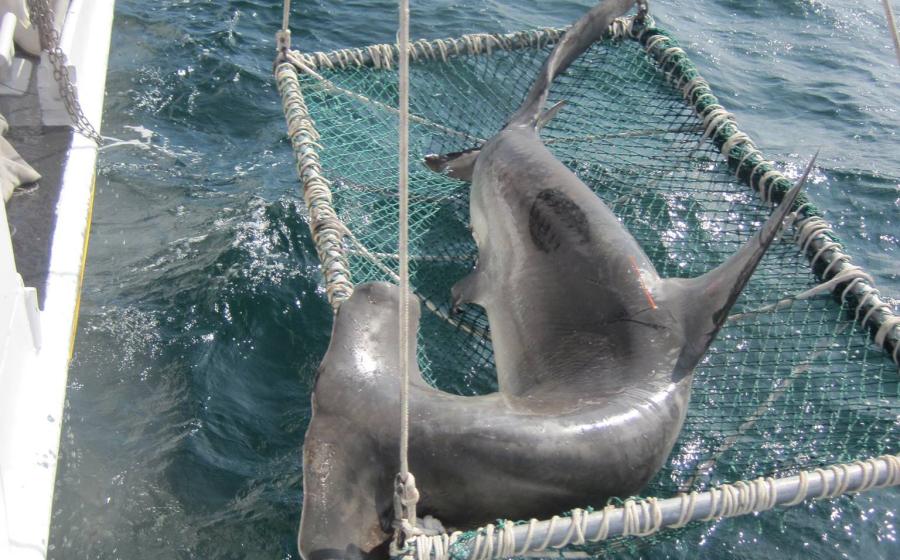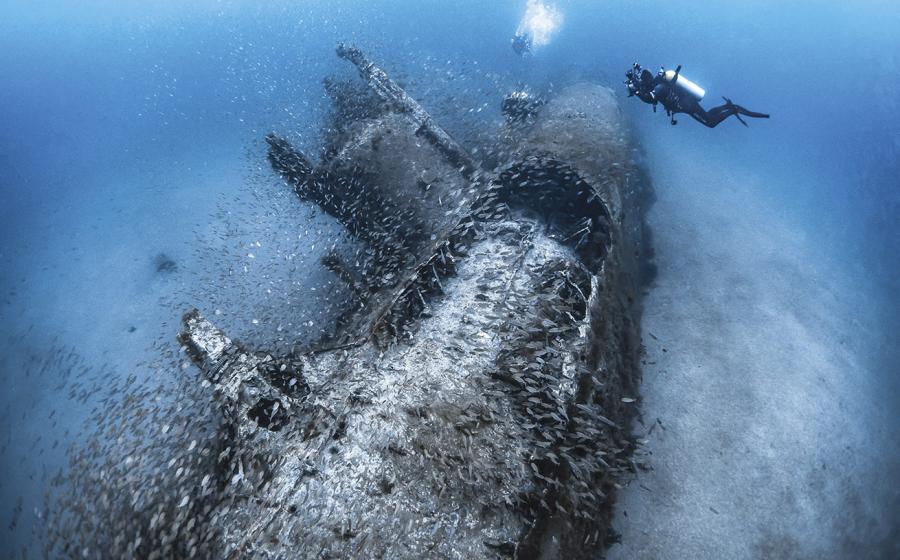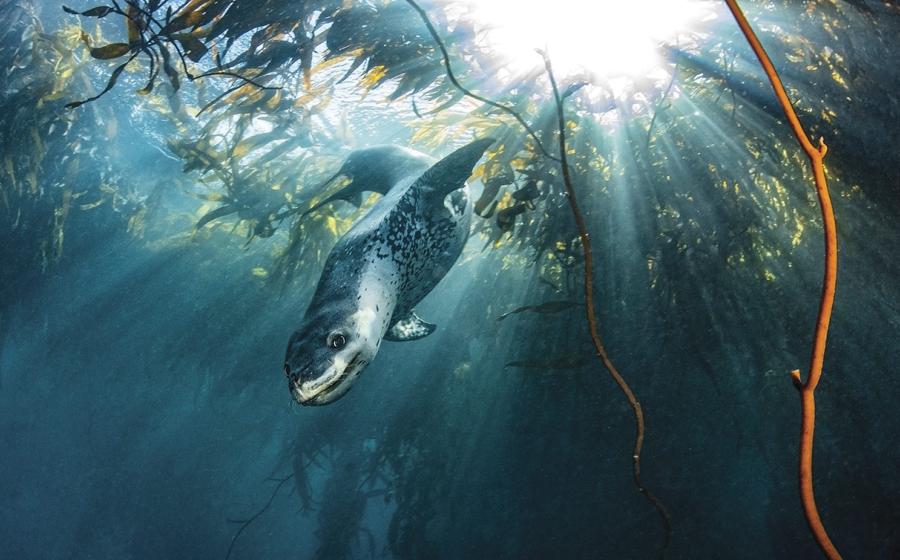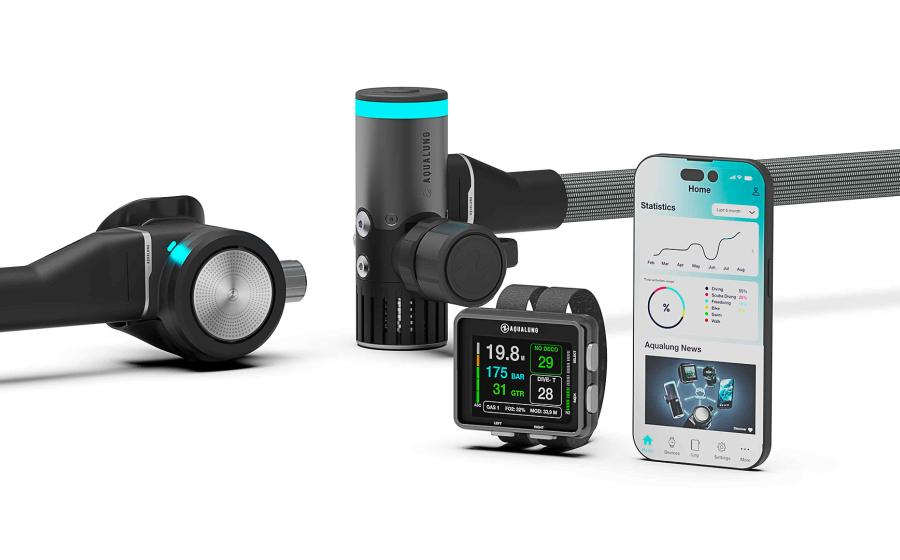Face-Off: ScubaLab Tests 9 Full Face Masks
This year, ScubaLab conducted its first-ever test of full-face masks for the January/February issue of Scuba Diving magazine. All of the masks tested were subjected to ScubaLab's rigorous test protocols including both lab testing on an ANTSTI breathing machine as well as real-world ergonomic testing conducted by test divers.
Masks were evaluated for ease of breathing, comfort, adjustability, field of view, ease of equalizing and other aspects related to performance. Below are the complete findings of our tests.
How We Test
Ergonomic testing was conducted at Blue Grotto Dive Resort in Williston, Florida, where test divers equipped with underwater slates scored masks in 12 performance categories from 1 to 5 and recorded their observations while using each mask. After testing, divers pick their favorite masks. We wanted our test to evaluate masks from a recreational diving perspective. Our group of test divers included well seasoned openwater divers with years of experience who were recently trained on full-face masks and experienced full-face mask divers, including PADI Full Face Mask Diver specialty instructors.
Test divers ranked masks in the following categories:
Donning Ease of assembly and putting on the mask? Are buckles and straps easy and secure to operate?
Comfort Does the mask fi t your face? Is the skirt comfortable and soft? Do frame or other components rub or sit uncomfortably?
Surface Breathing Ease and effectiveness of breathing atmospheric air at the surface
Equalization Ease of performing Valsalva maneuver to clear ears
Seal Does skirt form a comfortable, effective seal?
Field of View To what degree did the mask frame or skirt block your view? Is it prone to fogging, or is the view distorted?
Sound and Bubbles How well does the reg deflect bubbles from your field of view and the side of your head?
Ease and Dryness of Breathing Evaluated in normal swim position, face-up, and headdown
Dewater How difficult is it to clear water from the mask?
Ease of Doffing How easy is it to remove the mask?
We also evaluated the ease of removing and replacing each mask underwater and clearing a fully flooded mask in a swimming pool.
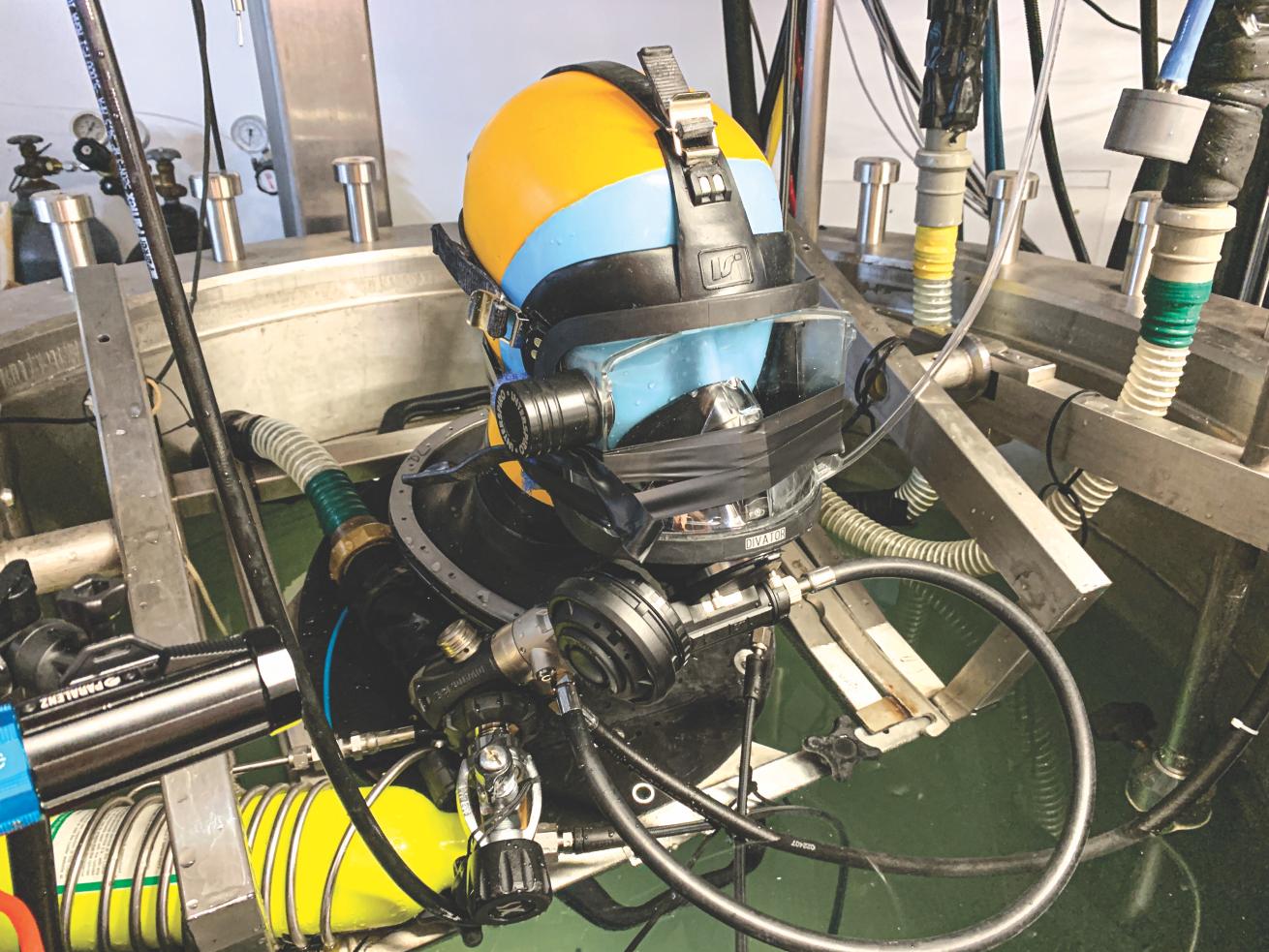
ROBBY MYERSErgonomic testing
Objective testing was conducted at Dive Lab in Panama City Beach, Florida, using Scuba- Lab’s regulator test protocols on an ANSTI breathing simulator to measure the amount of effort (“work of breathing”) required to inhale and exhale through the mask using a given reg at a series of depths and breathing rates. A Scubapro MK25 EVO BT first stage and G260 second stage were used for any mask submitted without a reg.
Our testing is not designed to pass or fail masks, but to compare performance in controlled conditions. The graphics accompanying each review display breathing performance in four of our test conditions, starting with a somewhat aggressive breathing rate at the maximum recreational depth.
Click here to download the complete ANSTI data for each mask.
How We Score
Our scoring for ergonomic and objective categories is as follows:
5 – excellent
4 - very good
3 – good
2 – fair
1 - poor
Why Dive Full-Face?
Comms With the addition of a wired or wireless communication system, FFM divers can speak with other divers and/ or surface support.
Protection Since less of the face is exposed to water, FFMs keep divers drier and warmer. It also keeps contaminated water away from the eyes, nose and mouth.
Fit The large sealing surfaces on FFMs are generally very forgiving of different faces, so most divers can expect an effective, dry fit. Even with a less-than-perfect seal, positive pressure in most FFMs will leak air bubbles but keep water out.
Comfort The airspace created by the oral-nasal cavity means divers don’t have to bite down on a mouthpiece throughout their dive, reducing jaw fatigue. Additionally, FFMs often allow divers to breathe naturally through the nose.
Safety In the event a diver loses consciousness, the mask and reg will remain in place, providing a breathable airspace until help arrives.
Ask Robby
Q: Do I need a certification?
A: FFMs are very easy to use, but there are some important safety considerations to keep in mind. Removing an FFM at depth is especially jarring as it deprives you of both breathing gas and your vision. Training helps prevent major task-loading in the event of an emergency. Instruction also provides insight to help you get the most out of your mask, such as proper donning procedure, which impacts how well the mask seals. PADI offers a full-face mask specialty, and many manufacturers, such as Ocean Reef and Kirby Morgan, offer distinctive specialties tailored specifically to their masks.
OTS
Spectrum (Tested With ScubaPro MK25 EVO BT/G260)
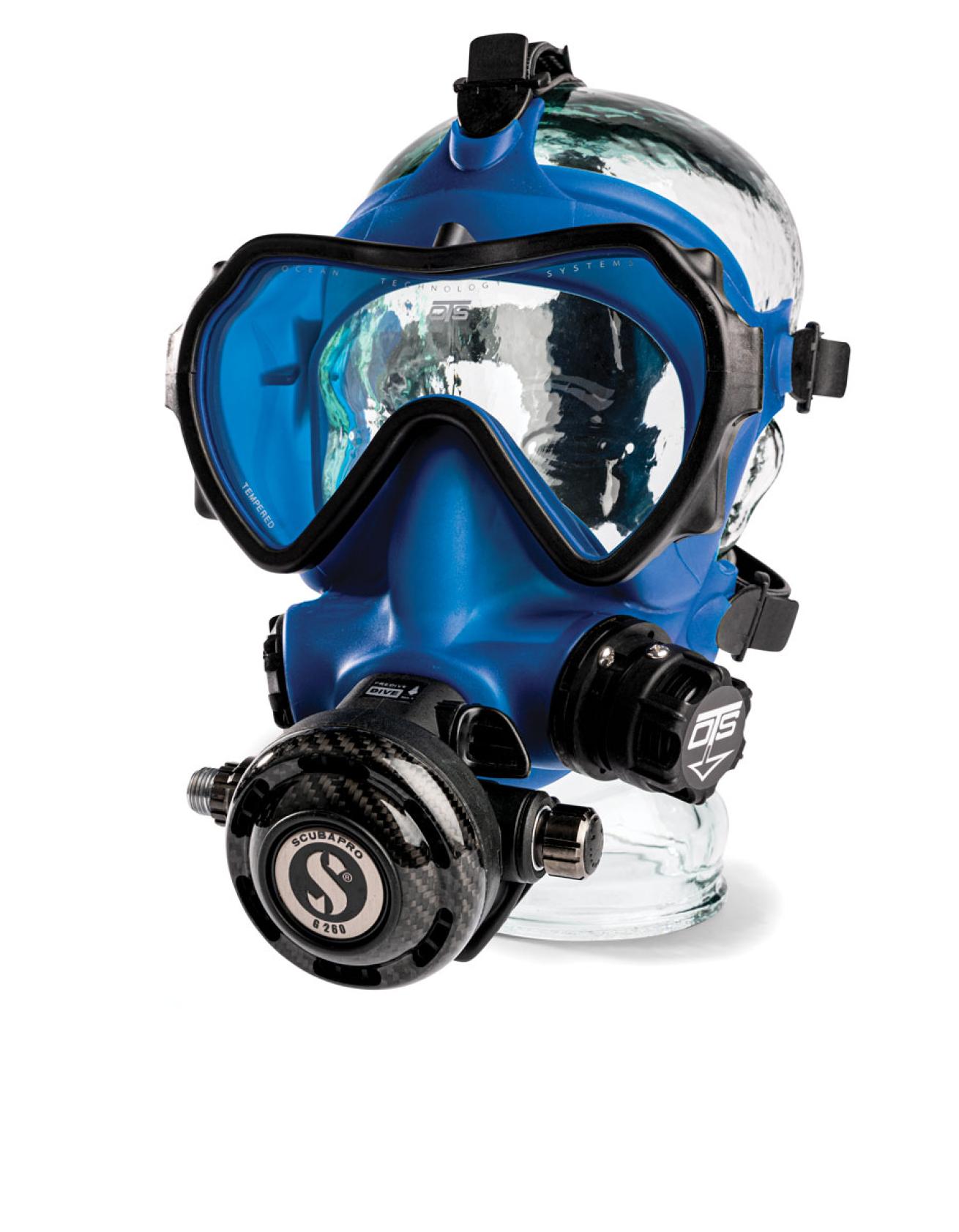
Monica MedinaMSRP Starts at $459 (mask only)
CONTACT oceantechnologysystems.com
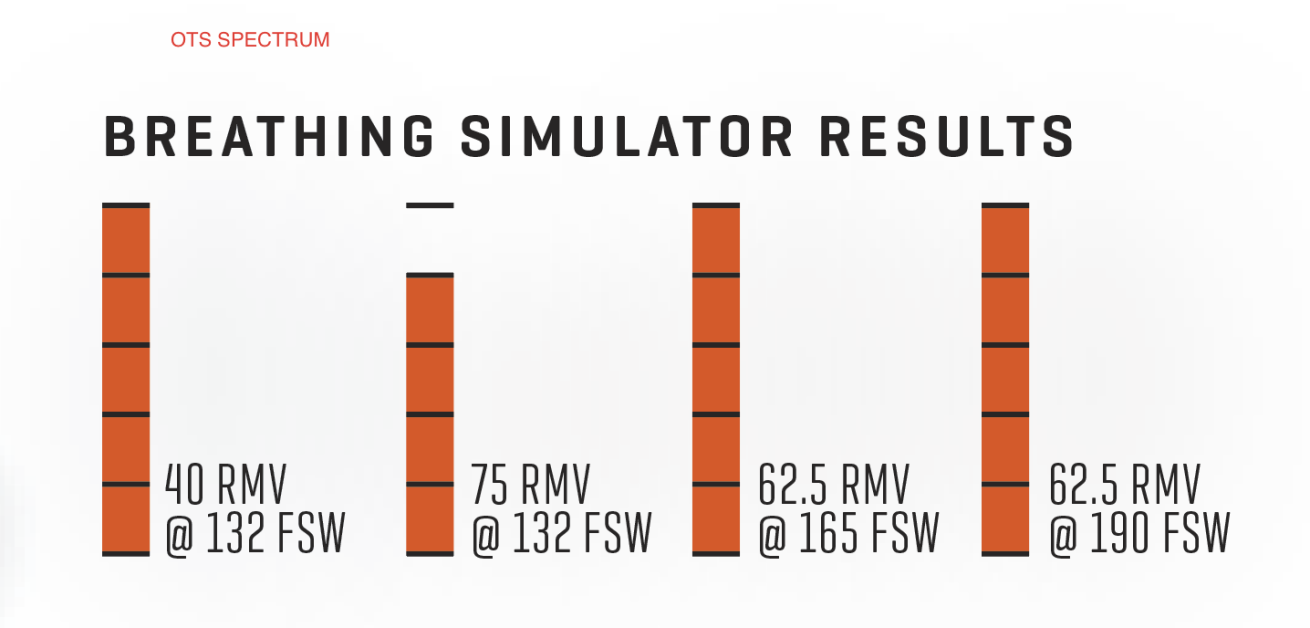
Robby MyersRATING
“Feels natural, like a regular mask/reg combo,” is how one tester described this lightweight mask, which is compatible with most standard regulators. A plastic frame provides support for the reg and accessories such as comms or surface breathing valve. The pliable skirt can be tricky to seat quickly—improper donning can put the lens right on the bridge of the nose—but provides an extremely dry and comfortable seal, even on divers with smaller faces. Testers loved the soft nose pocket, which allows for easy, effortless equalization. Outfitted with a high-performance reg, the mask earned excellent and very good scores for breathing on the simulator and in the field. However, some testers could feel the soft skirt suck in and out when breathing hard. The large glass lens—available clear or tinted—requires defog. It scored very good for field of view. The mask doesn’t have a dedicated dewatering valve, but a pull tab on the skirt helps expel residual water after clearing. A favorite of testers, offering comfort with an easy, effective seal and no-fuss equalization, the Spectrum is our Testers Choice.
DRAEGER
Panorama Nova Dive (Tested With Draeger Secor 7000)
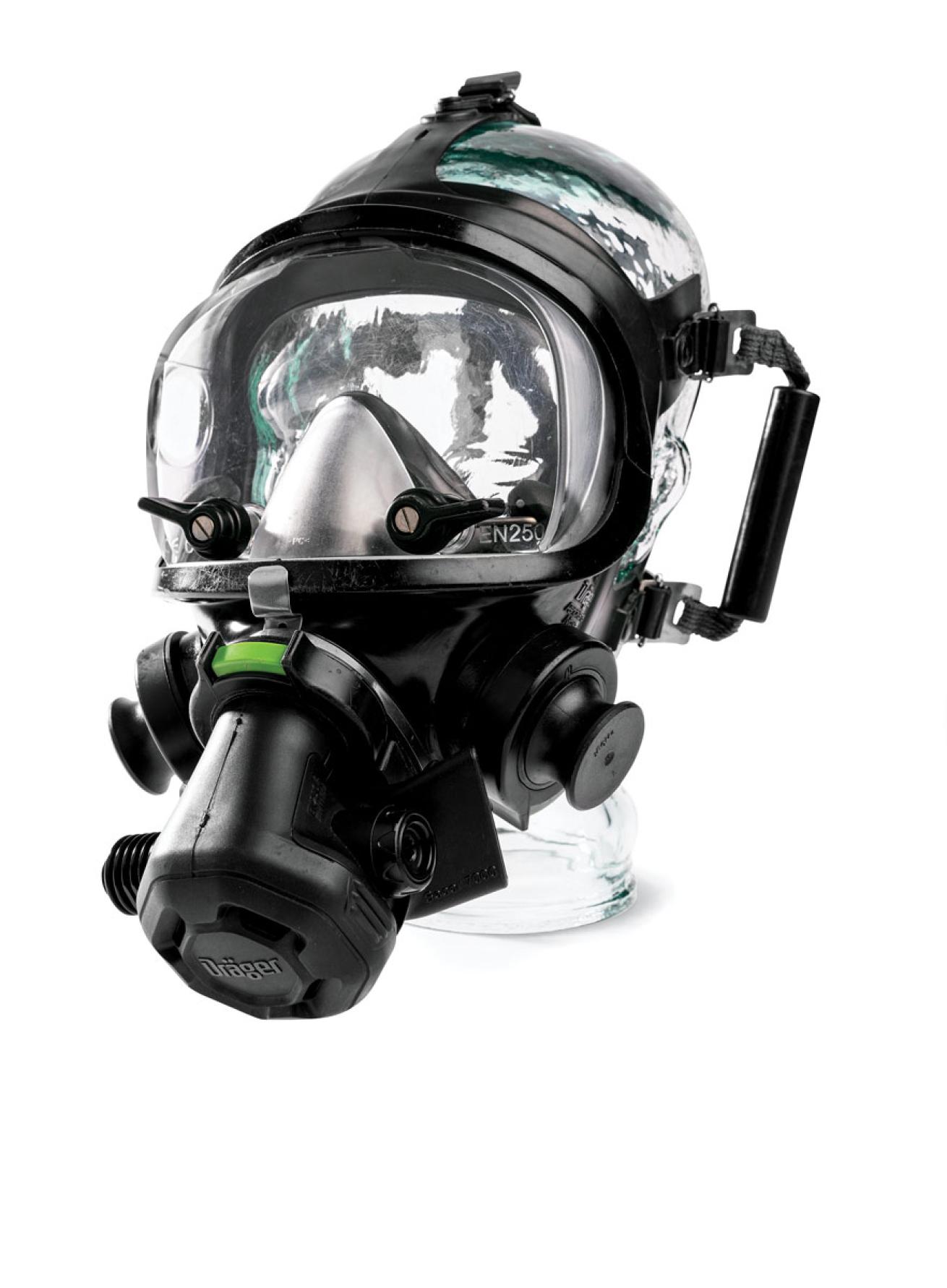
Monica MedinaMSRP Starts at $1,098 (mask only), $426 (reg)
CONTACT draeger.com
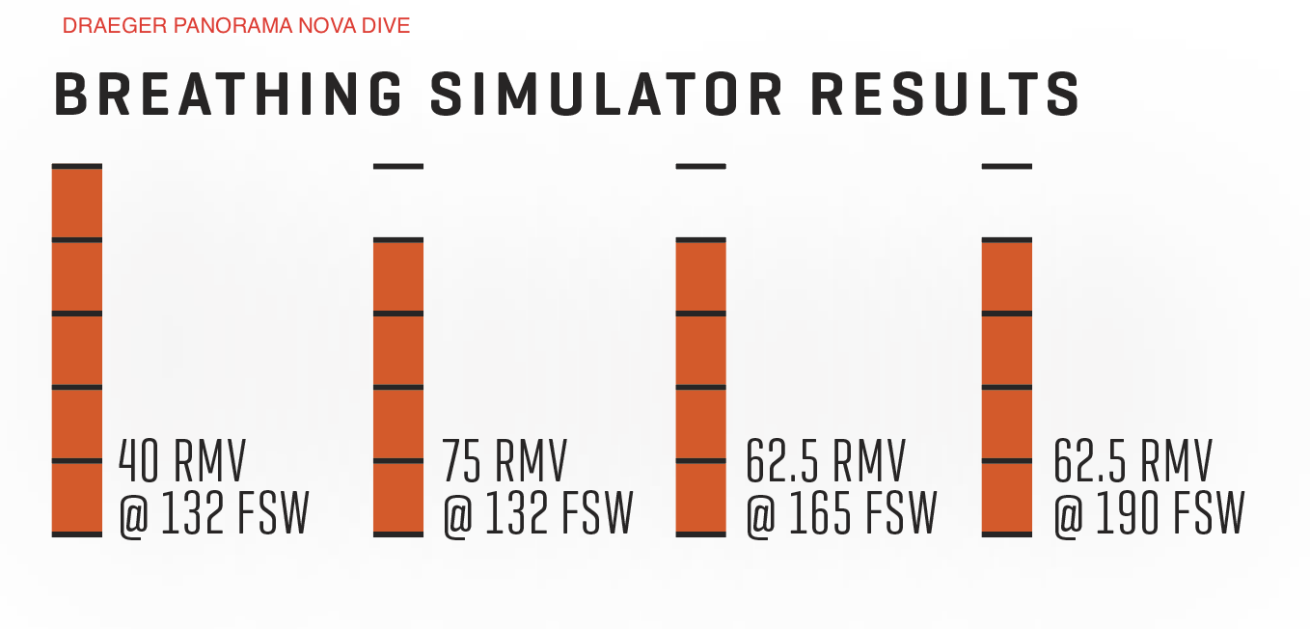
Robby MyersRATING
This mask earned excellent and very good scores on the breathing simulator. It earned good and very good scores in the water, but some divers noted they would have opened up the breathing adjustment a bit more had the reg been equipped with one. Large exhaust tees keep bubbles out of the diver’s field of view. The second stage quick-disconnect is stiff, but secure. The same can be said of the other two ports, whose dummy plugs can be removed to add communication systems or breathe ambient air at the surface—just don’t lose them. The skirt scored very good for the effectiveness of the seal. The clever windshield-wiper-like nose pinchers worked well for most test divers. Divers with small faces found the contraption landed too high on the face, which affected its effectiveness and the overall comfort of the mask. Testers loved the mask’s quick-release handles, which can be used to remove it in the blink of an eye. Dewatering the mask is almost effortless, with water clearing quickly and easily. “Practically cleared with the bubbles I was trickling out [of my mouth],” one tester said. Overall, the Panorama Nova Dive is comfortable and capable, with several clever and convenient features.
GULL
Mantis Full-Face (Tested With MK 25 EVO BT/G260)
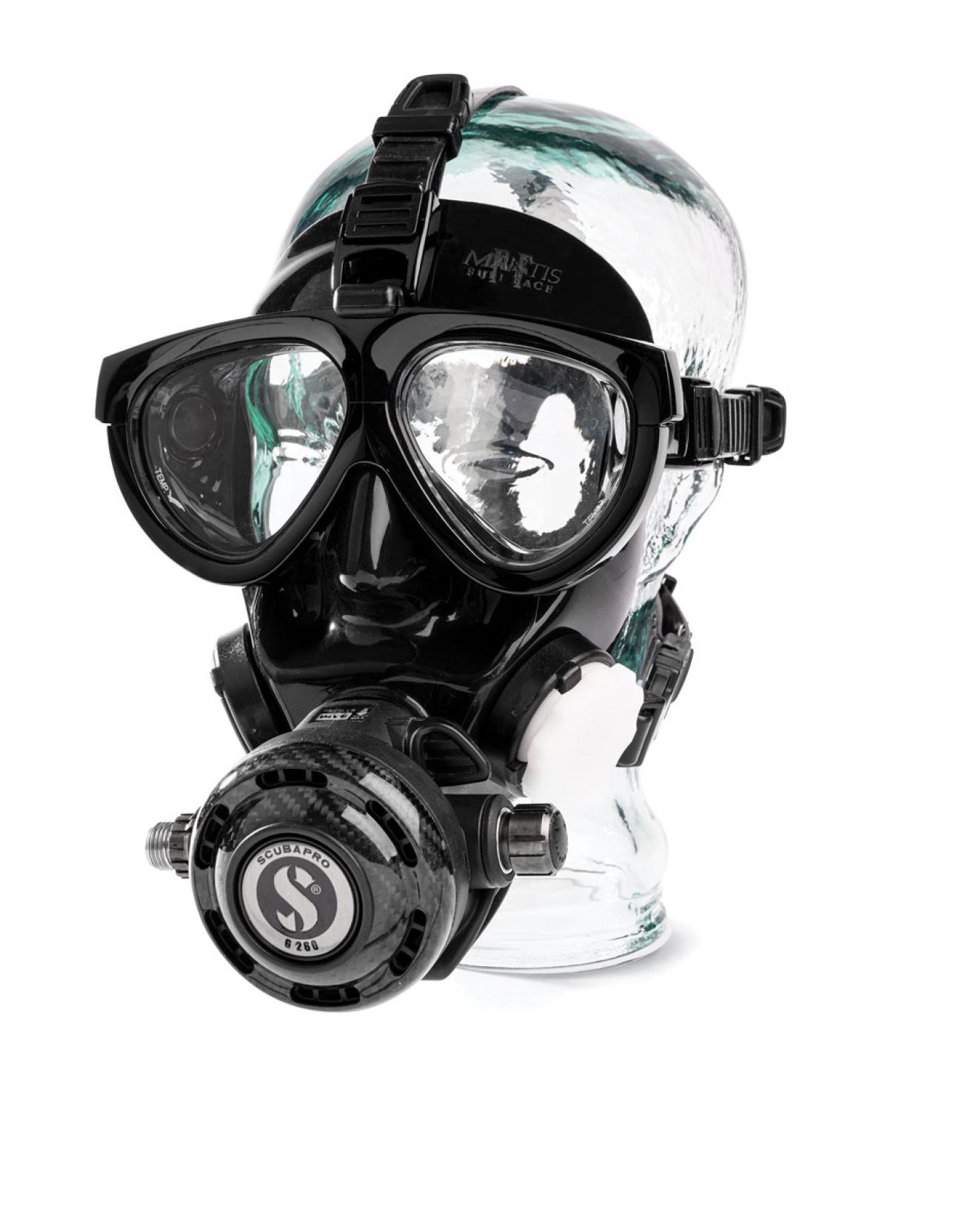
Monica MedinaMSRP Starts at $340 (mask only)
CONTACT gull.kinugawa-net.com
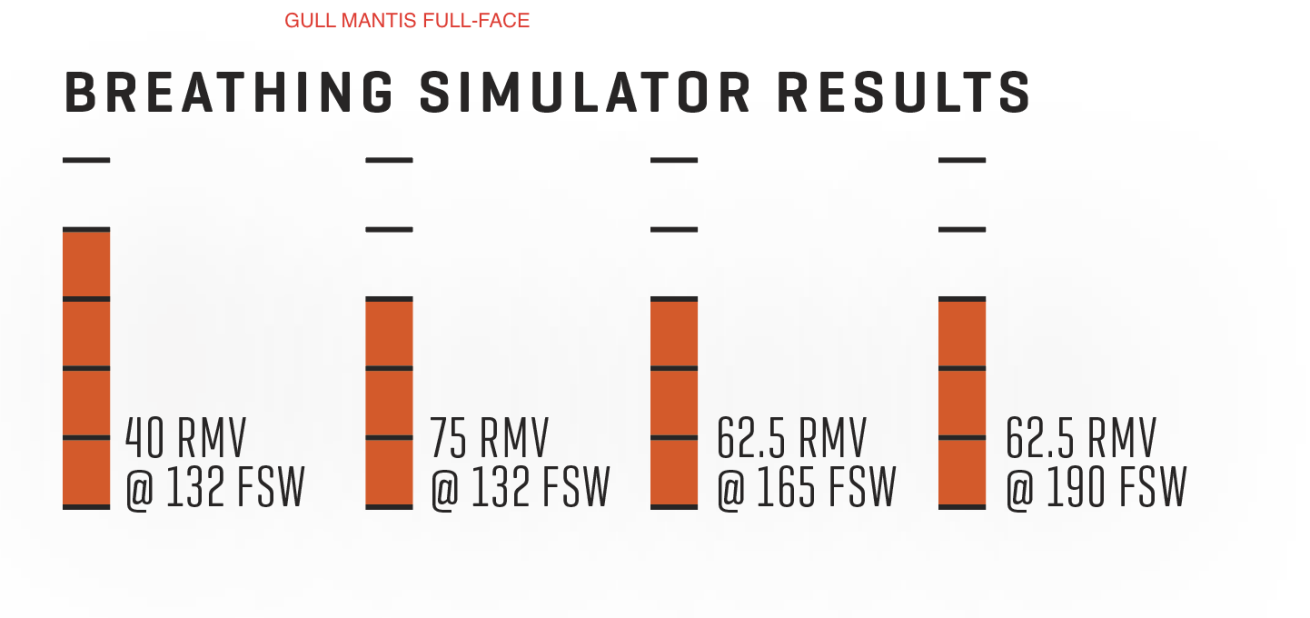
Robby MyersRATING
Like the Spectrum, users can dive this mask using their existing regulator. Stiffer silicone, an external attachment point and dual lenses allow for a minimized internal volume that puts the lenses right up to the eyes for a field of view comparable to a traditional scuba mask. Similarly, it requires defog. The soft nose pocket scored very good for access and ease of equalization. We recommend the optional neoprene harness cover, as adjusting the stiff, sticky straps can be a time consuming, hair-pulling process. Quick-disconnects on the jaw straps allow for quick doffing. One of our sample’s dual accessory ports was outfitted with a surface breathing valve, which is simple to use and provides a good airway. The low-relief knob can be hard to turn while wearing gloves. The mask earned solid breathing scores on the simulator and from testers. The skirt seems intended for wider, flatter faces. Divers who experienced a solid fit counted the Mantis among their favorites.
INTERSPIRO
Divator (Tested With Interspiro RS4)
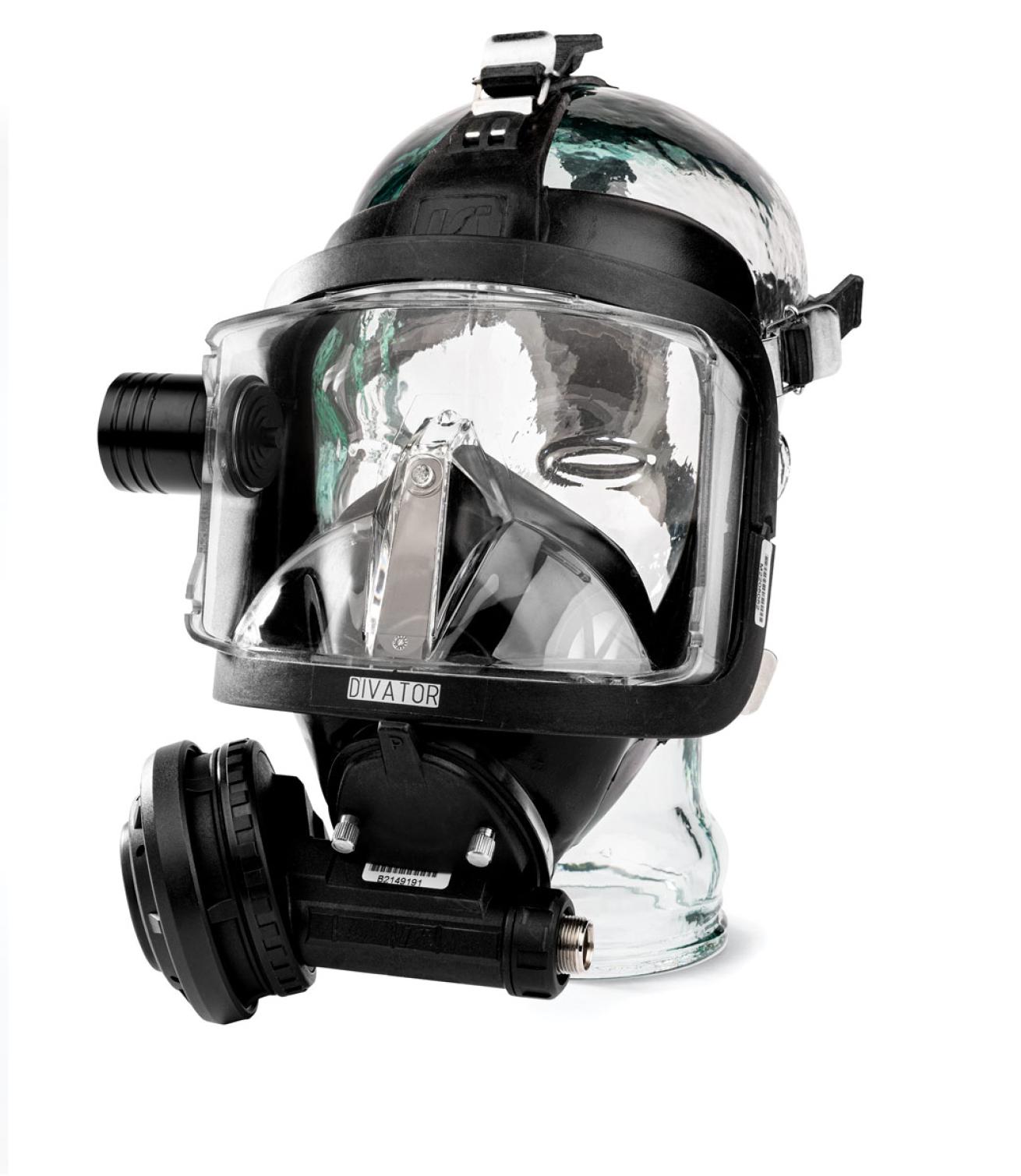
Monica MedinaMSRP Starts at $1,270.09 (mask and second stage)
CONTACT interspiro.com
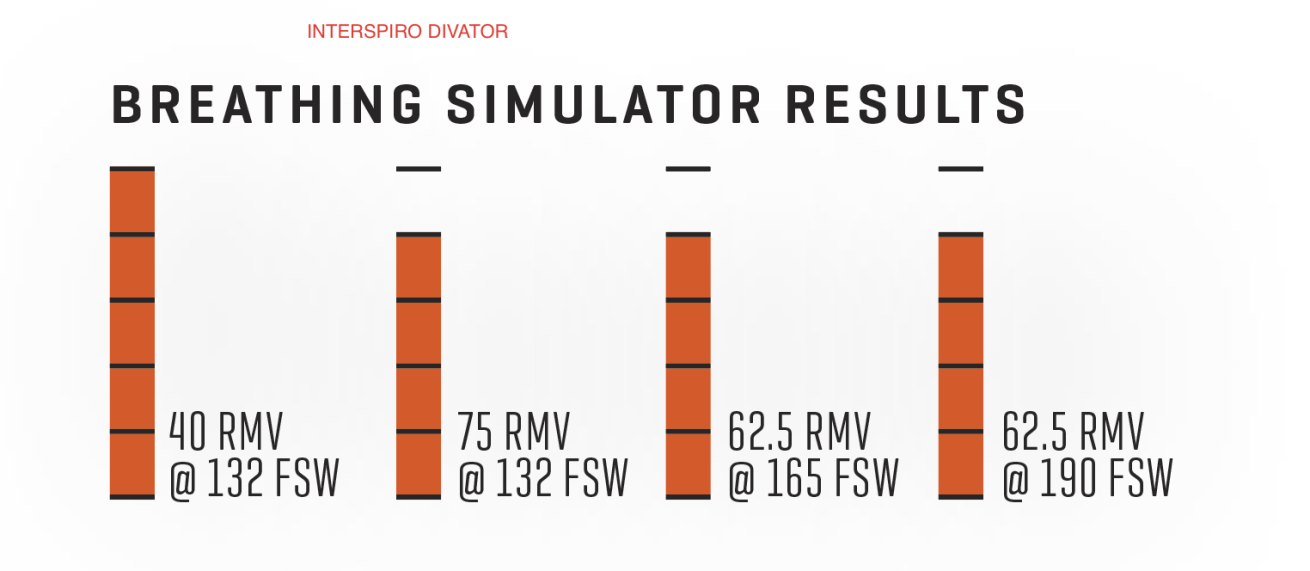
Robby MyersRATING
The Divator (also known as the Aga mask) is available with either a silicone or natural rubber skirt. Both versions proved a ready fit for all of our test divers and provided a comfortable, effective seal even on divers with smaller faces. An adjustable rubber block is used to seal the nostrils while equalizing. Divers really liked the location and easy pull-open/push-closed operation of the optional surface breathing valve. The mask took the top score for field of view, which test divers described as “wide” and “perfectly natural.” The harness securely holds the mask in place—along with any stray hairs it can latch onto. The included second stage uses a left-side supply hose. It earned excellent scores on the simulator and very good scores in the water. “So quiet and easy-breathing,” is how one test diver described the mask. The Divator can be disassembled without tools for maintenance or to add communications. With very good scores across the board this old-school mask was a favorite of multiple test divers.
KIRBY MORGAN
M - 48 SuperMask (Tested With ScubaPro MK 25 EVO BT/Kirby Morgan Balanced)
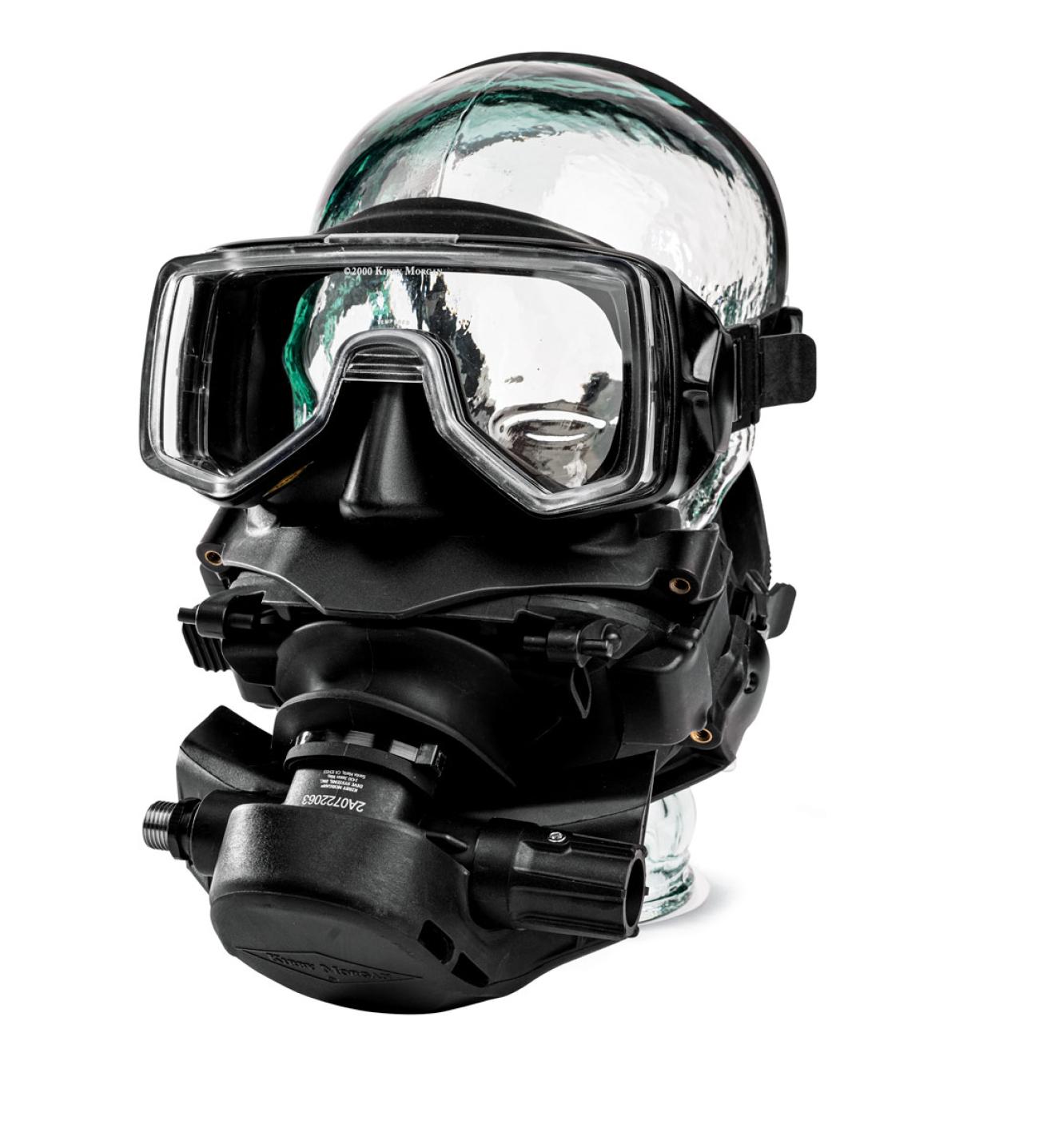
Monica MedinaMSRP Starts at $379.50 (mask only), $181.75 (scuba POD w/o reg)
CONTACT kirbymorgan.com
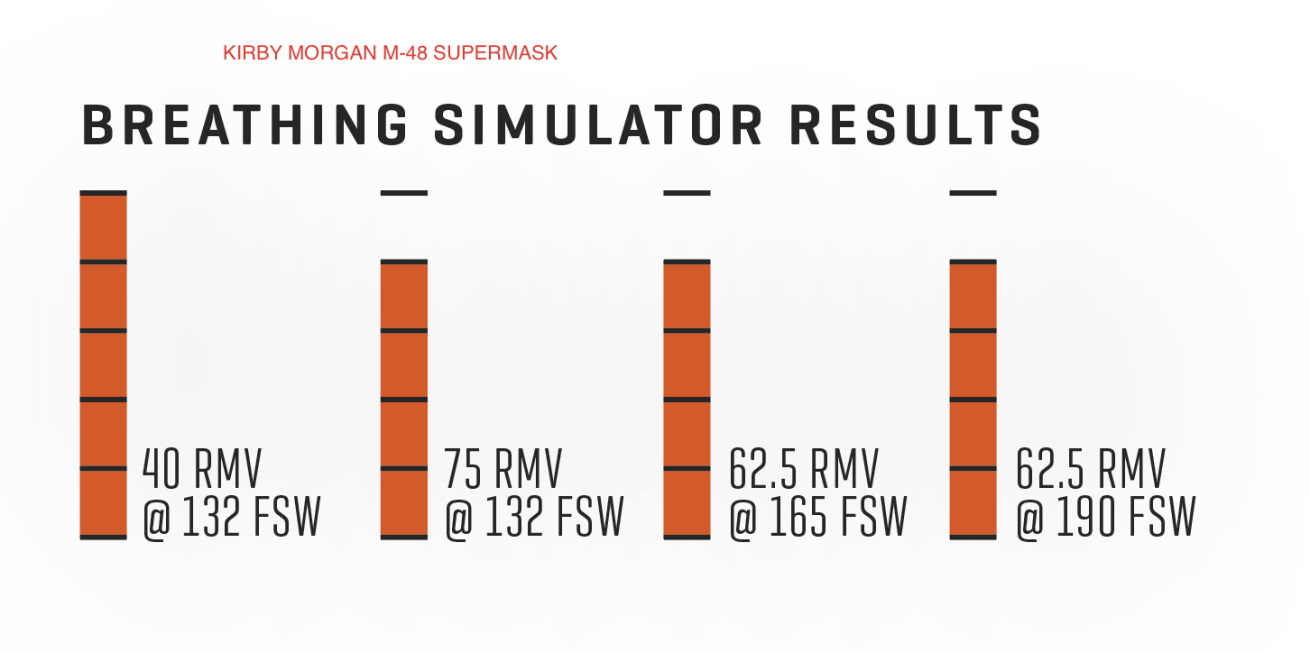
Robby MyersRATING
This modular mask covers the diver’s entire face but has two air cavities: one for the eyes and nose, and another for the mouth. The second stage adapter—or POD—can be used with most regs. It snaps securely into place and can easily be disengaged to breathe surface air or quickly switch regs. A mouthpiece makes it easy to clear an airway after flooding the mask and allows for buddy breathing. It also provides a noticeable Venturi effect that helped the mask breathe very easily. The boxy wraparound lens has a wide view; the clear sided version has a “wonky” blind spot. The lens overhangs the big soft nose pocket, which can make it challenging to equalize. The four-point strap is easy to adjust and is “super comfortable on land and in water,” according to one tester. The SuperMask showed strong performance across the board and was a favorite of test divers.
KIRBY MORGAN
M-48 MOD-1 (Tested With ScubaPro MK 25 EVO BT/ Kirby Morgan Balanced)
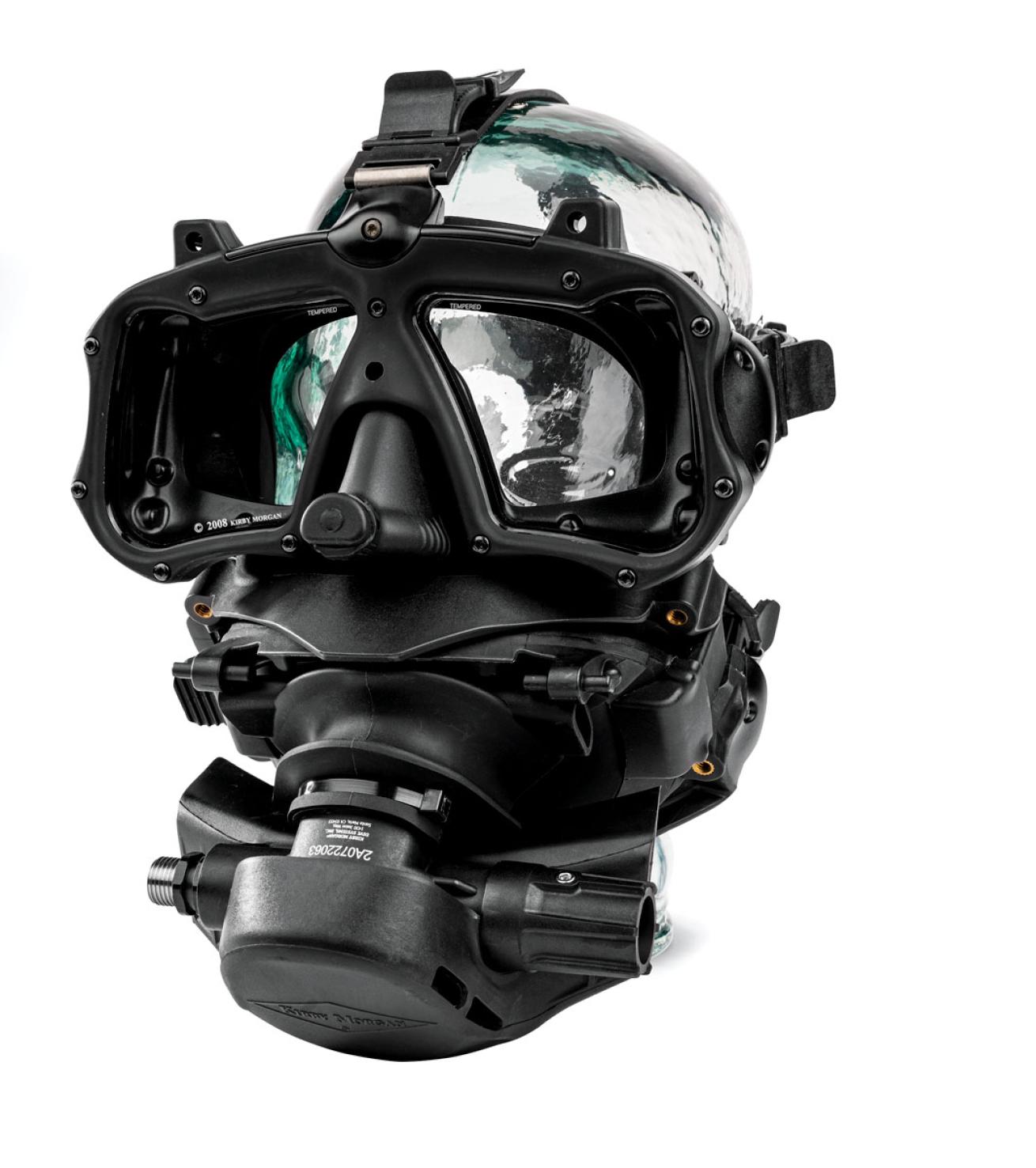
Monica MedinaMSRP Starts at $865.95 (mask only), $181.75 (scuba POD w/o reg)
CONTACT kirbymorgan.com
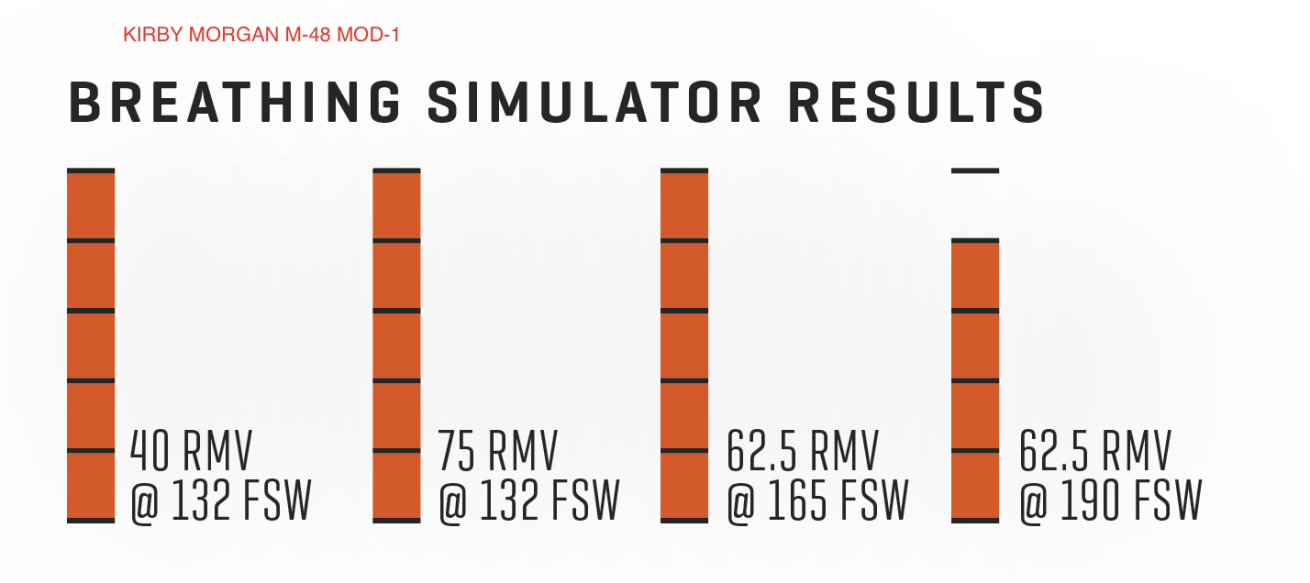
Robby MyersRATING
Using the same modular concept, the MOD-1 is larger than the SuperMask, but no less comfortable. Dual glass lenses sit at a distance from the eyes, limiting field of view. But the large volume clears readily, draining water into the lower cavity for easy expulsion through the reg or the dedicated exhaust valve. Tong-like nose pinchers hidden in the soft nose can reach far back into the mask for easy equalization, but can be slippery when the nose or clamps are wet. The frame and chin cup make it easy to seat the mask on the face, and the five-point harness is very easy and secure to adjust. This mask had some of the best breathing scores in the test. Testers loved the optional hood, which bolts directly to the mask without compromising the seal or complicating donning. “Couldn't believe it was bone-dry. So warm and comfy,” one test diver said. The MOD-1 offers heavy-hitting performance and outstanding comfort.
OCEAN REEF
Neptune III (Tested With Ocean Reef Neptune III Regulator)
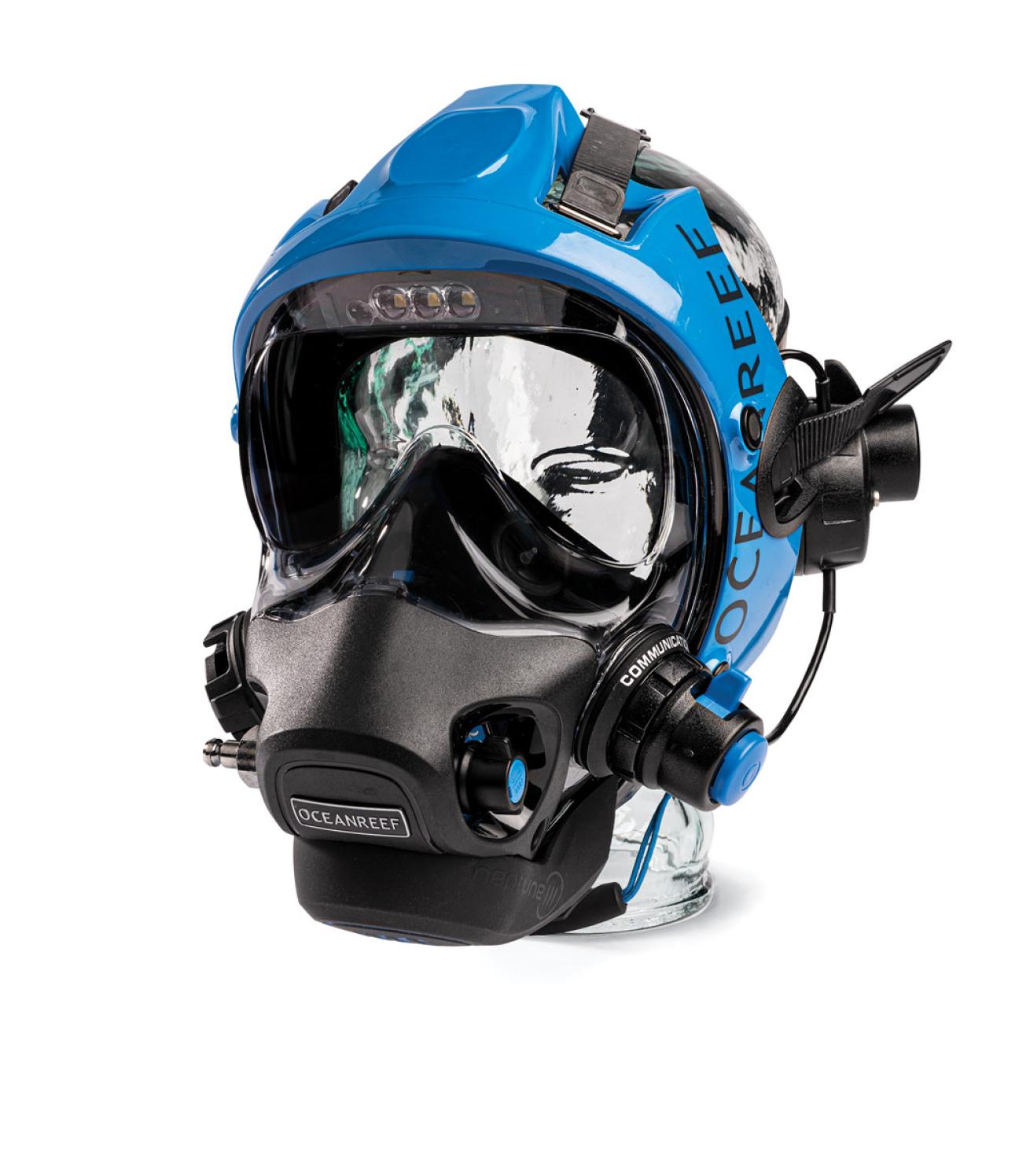
Monica MedinaMSRP Starts at $1,650 (includes mask, reg, extender kit and backpack)
CONTACT diving.oceanreefgroup.com
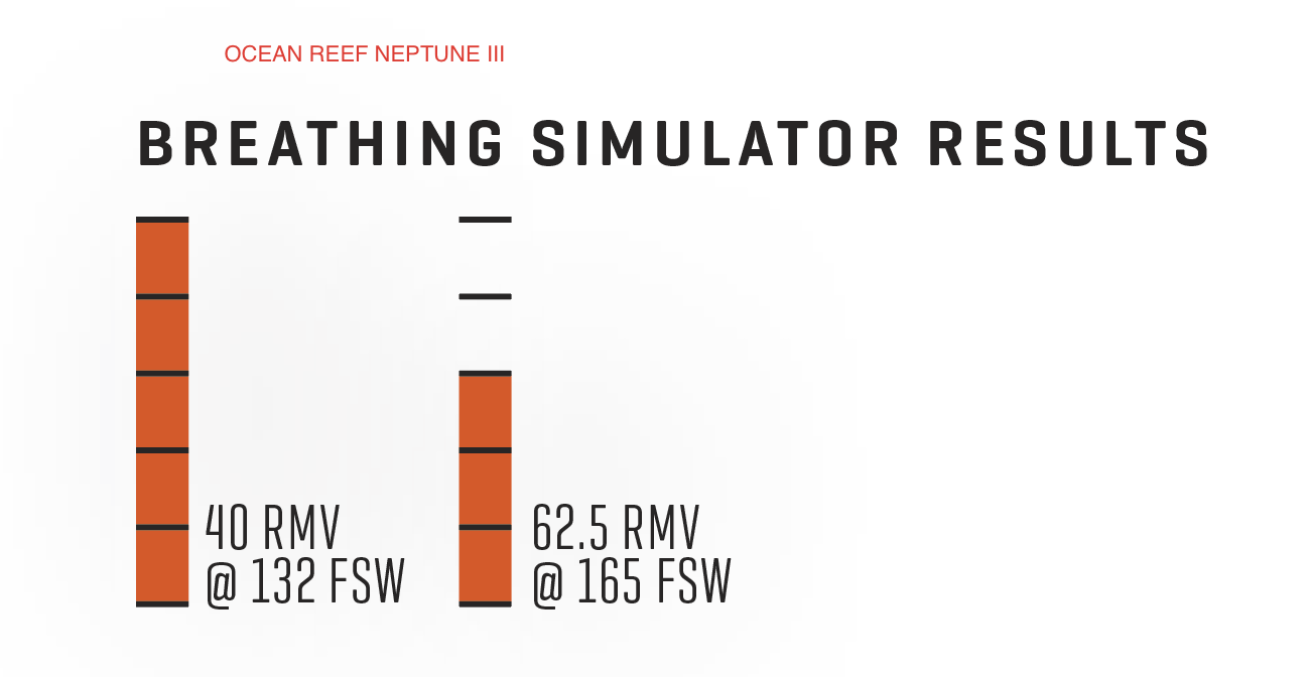
Robby MyersRATING
With a built-in reg (available with low-pressure quick-disconnect) and a large, durable frame, this mask looks and feels bulkier than some of the others. The trade-off is a stylish, super comfy and dry mask with lots of well-integrated accessories, including a quick-release handle and surface valve, along with optional features such as communications and a headlight. The large viewing pane, with curved, transparent edges, provides a panoramic field of view. Dual nose plugs offer enough adjustment that anyone can get a proper seal, but testers were divided on the ergonomics of the system. The six harness straps can be difficult to fish out from the frame quickly. The mask took top score for ease of clearing. On the simulator, it earned excellent and very good scores at low to moderate work rates down to 165 feet. With solid performance and great attention to detail, the Neptune III was a favorite of test divers.
OTS
Guardian (Tested With ScubaPro MK25 EVO BT)
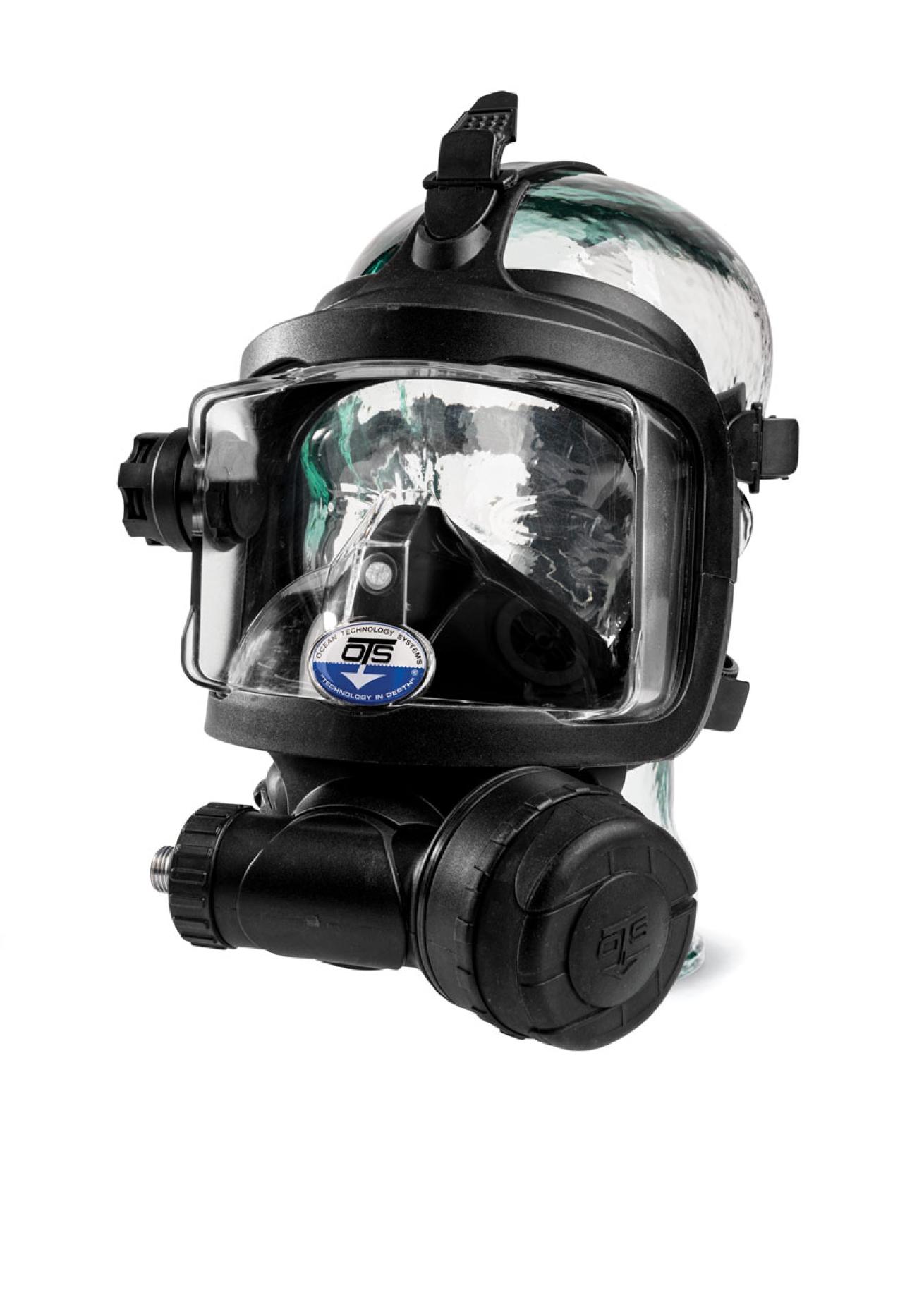
Monica MedinaMSRP Starts at $899 (mask and second stage)
CONTACT oceantechnologysystems.com
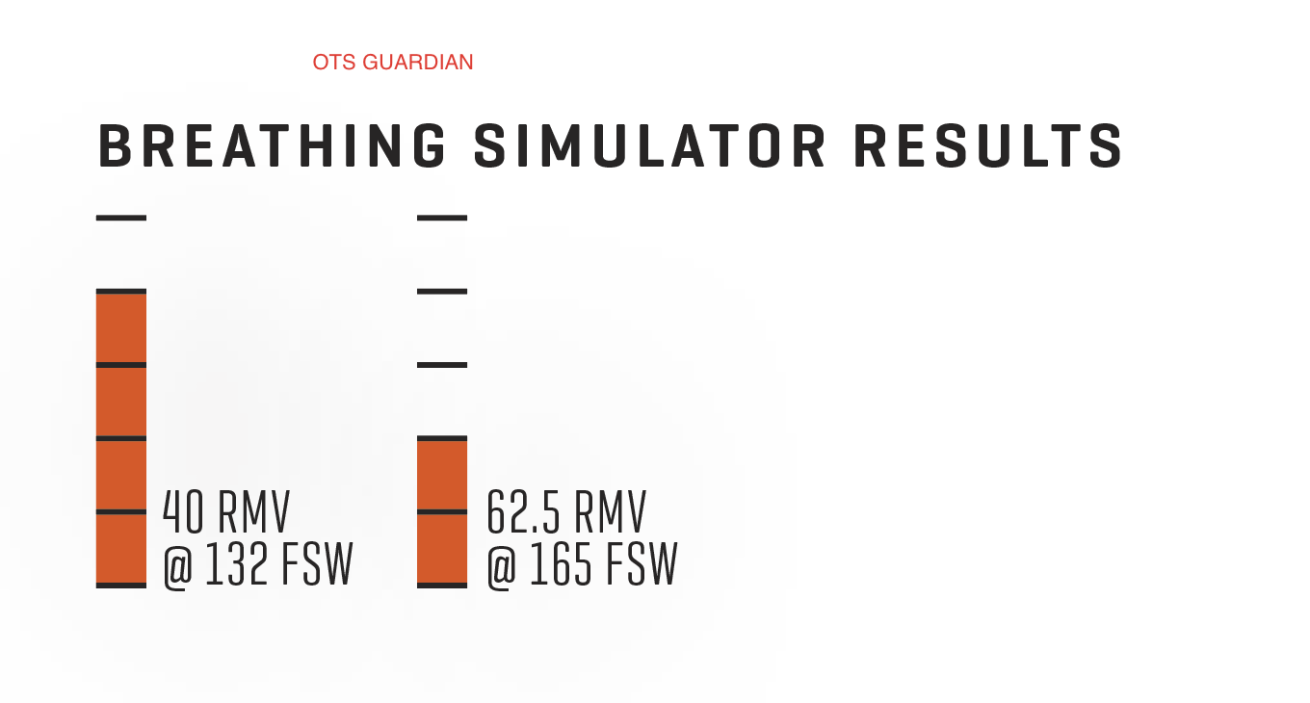
Robby MyersRATING
Capable and comfortable, this mask was a favorite of several test divers. It is outfitted with a quick-disconnect second stage that allows divers to attach the reg after properly seating and adjusting the mask, simplifying donning. On the simulator, it earned excellent and very good breathing scores at low to moderate work rates down to 165 feet. It also took high scores in the water, including top score for ease and dryness of breathing in head-down position. “Perfectly clear and dry,” one tester said. The two-piece equalization block provides additional customization options to adjust shape and height for easier equalization. The included temple-mounted surface valve took top score thanks to its ergonomics and convenient location. Easy-to-access ports make the process of upgrading the system with comm systems very straightforward. “Rugged, reliable and simple,” is how one tester described the Guardian.
POSEIDON
Atmosphere (Tested With Poseidon Xstream)
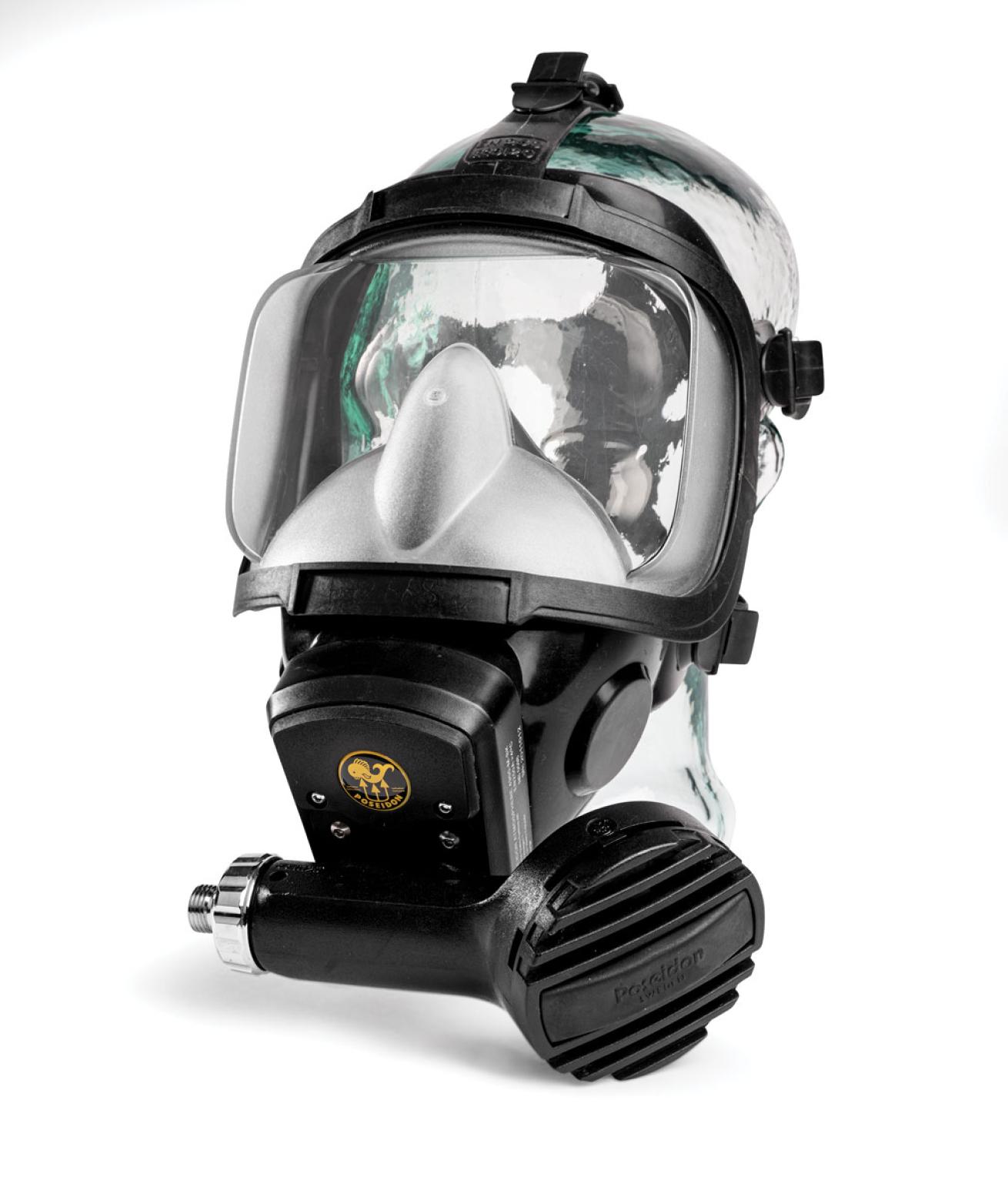
Monica MedinaMSRP Starts at $1,599.95 (mask with second stage)
CONTACT poseidon.com
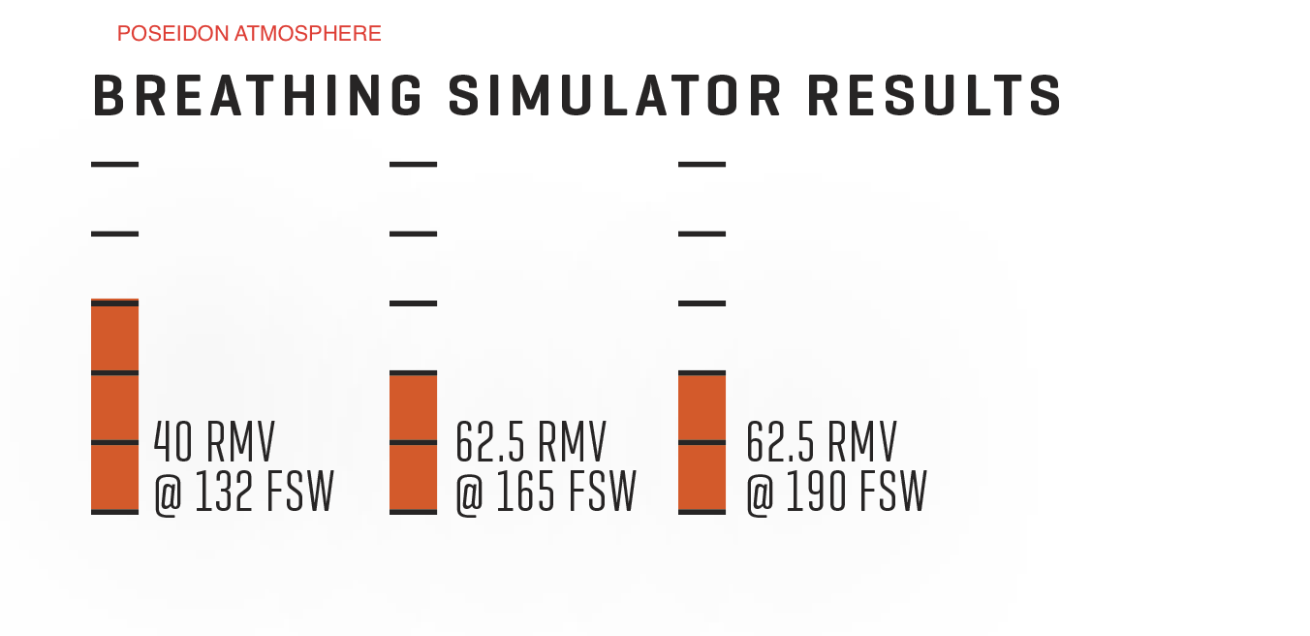
Robby MyersRATING
This no-frills mask keeps things simple and streamlined—it isn’t even equipped with a surface breathing valve. With no extras to get hung up on, the mask is lightweight, easy to don, and doesn’t have anything to interrupt the diver’s line of sight. “Surprisingly comfortable, with a good field of view,” is how one tester described it. The mask is comfortable and seals well, but divers with smaller faces had difficulties fitting the mask. The harness scored very good for ease of donning. “Good buckles and straps,” one test diver noted. The included Jetstream second stage (which is modified specifically for the mask) keeps exhaust off to the side and features a dive/predive switch to prevent free-flows when the mask is off the diver’s face. The purge is incredibly powerful and often spits water at the diver’s face during clearing. Fortunately, the mask is also easy to clear using the diver’s exhalations. Testers noted that the reg seemed harder to breathe compared to the others, scoring good for ease/dryness of breathing. On the simulator, the reg struggled at higher work rates, but earned consistently good and very good scores across our test depths. At 10 RMV, work of breathing even improved at 190 feet.
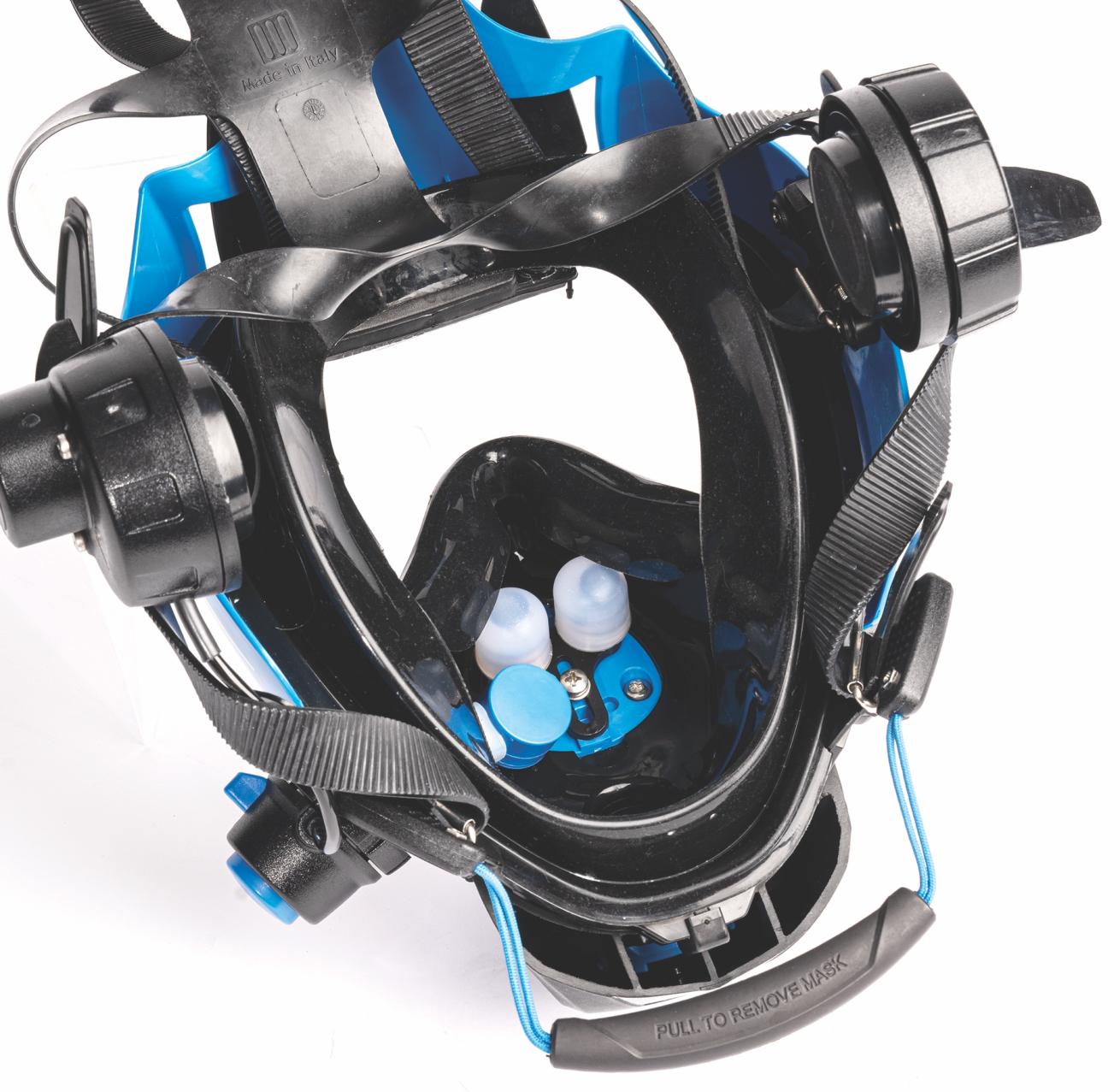
Monica MedinaFull Face Mask
The Nose Knows
Performing the Valsalva maneuver is a procedure that varies greatly depending on which full face mask you dive with. Many use a height-adjustable block that seals against the nose when pushing the mask against the face. The system is simple to use but can only be so accommodating. The Neptune uses a similar method. However, its dual nose plugs can be raised, lengthened and individually rotated for a custom fit. For a more natural motion, some masks, such as the Panorama Nova and MOD-1, use mechanical pinchers. Test divers found the soft nose pockets on the Spectrum and Gull to be very comfortable and effective, as they are just as easy to equalize with as a traditional mask.
Carbon Footprint
FFMs have a much larger volume than a typical scuba reg, resulting in a greater amount of reinspired CO2. Excessive CO2 can at the very least cause confusion and rapid breathing. Because of this the U.S. Navy limits reinspired CO2 to no more than 2% (20 millibars) at all breathing test rates. However, the European CE standard EN-250, limits the CO2 at the low breathing test rate of 10 RMV to 2% (20 millibars) and only 1 (10 millibars) at the high work rate of 62.5 RMV.
To measure the reinspired CO2, each mask was tested at 10 RMV and 40 RMV. Forty RMV was chosen as the highend sustained recreational rate. Ten RMV is made up of 10 1-liter breaths in one minute, and 40 RMV consists of 20 2-liter breaths in one minute.
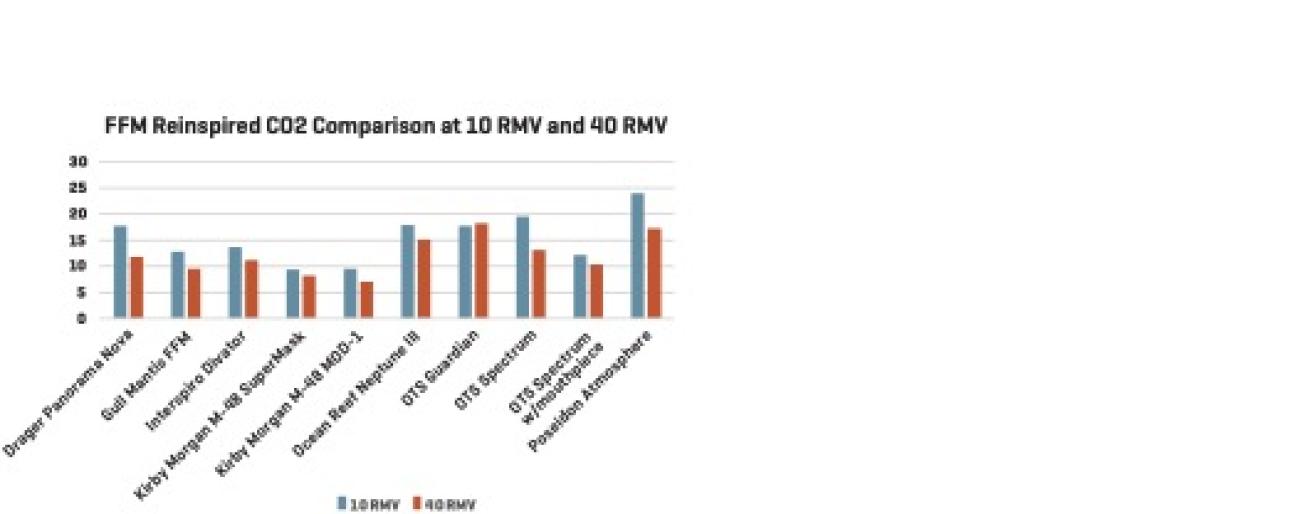
ROBBY MYERSCarbon Footprint Bar Graph
As shown in the chart above, testing showed that most of the masks would fail to meet the CE requirement of 1% (10 millibars) at the 40 RMV test rate, but most would pass if the U.S. Navy 2% (20 millibars) is used. Physical volume in the mask can cause CO2 buildup, so reducing the volume of the mask or, if possible, adding a mouthpiece, can significantly reduce dead space and reinspired CO2. The chart displays the reduction in CO2 that resulted from adding a mouthpiece to the Spectrum, without the mouthpiece sealed inside the mouth. In a real-world scenario, the CO2 numbers would be even lower According to Dive Lab, staying below the 10 millibar limit may not be achievable with many FFMs unless a mouthpiece is used. For more information on CO2 testing, visit divelab.com.

